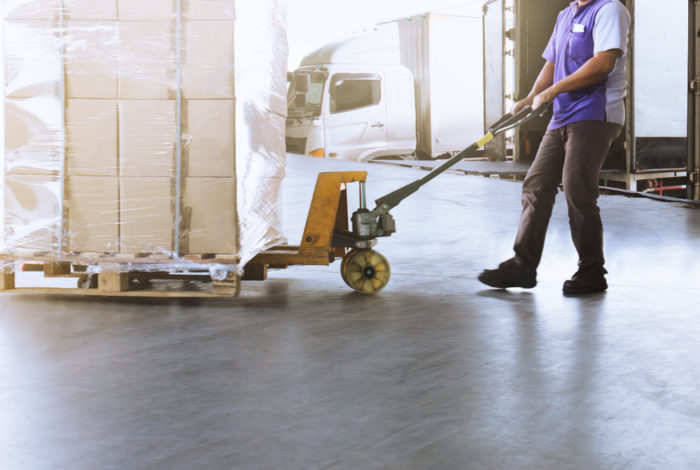Key Takeaways
- The major pallet pools that use multi-use block pallets are comprised of either wood or plastic pallets, each with their own pros and cons.
- While these segments overlap throughout the supply chain, the ways in which they respond to market forces can differ.
- The majority of pallets produced continue to be made of wood, although plastic has quickly become a major market player.
- Steep fluctuations in lumber prices have slowed the growth of the wood pallet market.
- Plastic pallets also have key advantages over wood, including the fact that they are more lightweight and durable, and less likely to absorb moisture and harmful microbes or pathogens.
It is challenging to analyze the shipping pallet market, and even more difficult to draw conclusions regarding future trends. The major pallet pools that use multi-use block pallets are comprised either of wood and plastic pallets, each with their own set of advantages in terms of cost, durability, and sustainability. Wood stringer pallets also have their place within the supply chain, especially among smaller enterprises looking to cut down on costs.
And while these segments overlap throughout the supply chain, with many manufacturers using one, the other, or both materials, the ways in which they respond to market forces can differ.
Wood Dominates the Market, Though it Has Disadvantages
The majority of pallets produced continue to be made of wood, which is also one of the primary contributors to the municipal solid waste stream. Wooden pallets are made of hardwood timber, such as maple, oak, and walnut, and softwood timber, such as pine and spruce. Manufacturing and wood usage can vary according to region and the availability of trees.
The global wood pallet markets market, according to one source, was about $2.5 billion in 2023 and is expected to surpass $4 billion by 2033 based on growing demand for foods and beverages, building and construction materials, consumer electronics, and pharmaceuticals. Wood is widely available and generally considered to have lower up-front costs, when Total Cost of Business is not taken into account. Another reason for the dominance of wood is its widespread use; this material is what many longstanding manufacturers are most accustomed to.
But steep fluctuations in lumber prices, particularly during the recent pandemic, have limited the growth of the wood pallet market. Labor shortages and companies stocking up on excess inventories of cleaning supplies and other non-perishable goods, which occupied pallets and took them out of circulation, further strained the wood market.
In addition to block pallets, wood pallet manufacturers also make what are called stringer pallets. While sturdier block pallets can be accessed by a forklift from all four sides, stringer pallets, which are made of simpler construction, can typically only be accessed from the front or back.
The low cost of stringer pallets has made them desirable for certain enterprises, and increased pressure to cut costs of pallet construction and repairs has led to the use of cheaper and less durable woods. This makes these pallets less reliable and less consistent in their weight, size, and strength. This has led many major retailers, such as Costco, to require goods to be shipped on block pallets.
Focus on Cost, Sustainability Creates Greater Demand for Plastic Pallets

Although wood has traditionally dominated the market, studies show that lighter, more durable plastic pallets are quickly catching up. The market is expected to expand at a Compound Annual Growth Rate of more than 5 percent from 2024 to 2030, driven by pallets’ lightweight design, durability, and resistance to moisture and pathogens. Food and beverages account for the largest revenue share of the market, and more than 23 percent. Pharmaceuticals and consumer goods are also major drivers.
Reusable, recyclable plastic pallets have numerous advantages over wood block pallets. They are lighter, more durable, more consistent in their size and weight, and easier to keep clean. Although wood pallets can absorb moisture and harbor pathogens, plastic pallets are easily rinsed and sanitized. Wood also has a tendency to break and shed nails and splinters, which can create messes and pose hazards for vehicles, automated equipment, and workers.
Another challenge related to wood’s potential for breakage is rejected loads. When pallets aren’t up to par, most retailers will refuse them on sight to avoid stocking damaged products or risking injuries to worker and customers or damage to equipment. When loads are rejected, perishable products must be discarded, while returnable products must be transported back to the warehouse or fulfillment center, adding time and costs. Retailers may even charge a fee for bad pallets; such costs can quickly add up.
Plastic pallets are also more durable; an independent lifecycle analysis showed that iGPS plastic pallets last about four times as long as wood pallets before needing to be replaced (actual, not lab tested).
In addition to its recyclability, the lighter weight of plastic means that less fuel is consumed during shipping, with savings produced with every pallet shipped. Because less fuel is consumed, this also means that less greenhouse gas emissions are released into the atmosphere — making plastic the more environmentally friendly choice. Plastic pallets are also more durable; an independent lifecycle analysis showed that iGPS plastic pallets last about four times as long as wood pallets before needing to be replaced (actual, not lab tested).
Plastic pallets’ sanitization benefits are a key incentive for food and pharmaceutical manufacturers to make the switch to a plastic shipping platform. Plastic pallets are an ideal food-grade pallet that can aid food producers in meeting and even exceeding Food Safety Modernization Act standards for the safe transport of both human and animal food. Because the typical cost of a food recall is approximately $10 million and the Food and Drug Administration may also assess additional penalties, there are major motivating factors for food producers and shippers to comply with industry regulations and standards, which will likely enable plastic pallets to capture an even larger share of the expanding global pallet market.

Taken together, the advantages of plastic pallets, including less cleanup, less product damage, and lower transport costs, mean that companies can save up to $4.57 per pallet load by switching to plastic. In fact, when it comes to Total Cost of Business, many industry insiders would be surprised to learn that removing wood pallets from the supply chain altogether would also eliminate anywhere from $750 million to $3 billion in supply chain waste. When stacking up the pros and cons side by side, the advantages of plastic are clear — and it’s no surprise that when we look at the market size and trends, plastic continues steadily to challenge wood’s longstanding industry dominance.
In Conclusion — Frequently Asked Questions
What are the most popular pallets?
The most popular pallets are typically wood pallets. They are versatile, widely available, and have low up-front costs. The typical styles of wood pallets are block pallets and stringer pallets.
What is the pallet industry forecast?
The pallet industry is expected to continue growing, driven by increased e-commerce and global trade. Demand for pallets is likely to rise as businesses seek efficient and sustainable solutions for transporting goods. However, challenges such as rising lumber prices and an increased focus on sustainability may limit the wood industry’s growth.
What industry uses the most pallets?
The retail industry is the largest consumer of pallets, due to the high volume of goods transported, stored, and sold in retail stores. E-commerce companies, in particular, rely heavily on pallets for shipping products. Other industries that use a significant number of pallets include manufacturing and transportation.
What are the advantages of plastic pallets?
Plastic pallets offer several advantages over wooden pallets, including durability, sustainability, and hygiene. They are resistant to moisture, insects, and chemicals, making them ideal for transporting perishables and pharmaceuticals. Additionally, they are both lighter and recyclable, making them a more environmentally sustainable option.
Manufacturers looking to improve their supply chain optimization are making the switch to iGPS plastic pallets. These pallets are lighter, safer, and more environmentally sustainable. For more information, contact us at 1-800-884-0225 email a specialist at switch@igps.net, or visit our contact page.




